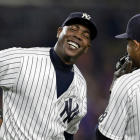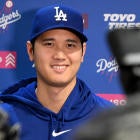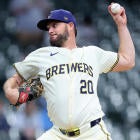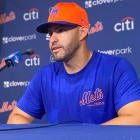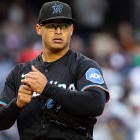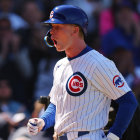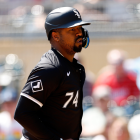Late Wednesday night, the New York Yankees landed the high-priced closer they apparently set out to sign this offseason. The team agreed to terms with ex-Yankee Aroldis Chapman, giving him a five-year contract worth $86 million. The deal includes no-trade protection and an opt-out after the third year.
Chapman, of course, spent the first half of the 2016 season with the Yankees before being traded to the Cubs. The timeline goes like this:
- December 28, 2015: Yankees acquire Chapman from the Reds for four non-top prospects after news of Chapman's alleged domestic violence incident lowers his stock drastically.
- July 25, 2016: Yankees trade Chapman to the Cubs for four players, most notably top prospect Gleyber Torres.
- December 7, 2016: Yankees re-sign Chapman to a five-year deal.
That is called having your cake and eating it too. The Yankees originally got Chapman for pennies on the dollar, flipping him for much more valuable prospects at the trade deadline, then re-signing him as a free agent. All in the span of 12 months. It's hard to get more opportunistic than that.

The Yankees are not a bona fide World Series contender at the moment, of course. Heck, they're not even a bona fide postseason contender. When a team drops $86 million on a one-inning reliever, you'd assume they're ready to win right now. That isn't the case here though. Chapman's short and long-term impact on the Yankees is very different.
2017: The Start of the Youth Movement
The Yankees actually started their youth movement back in 2015, when they opted to call up Greg Bird and Luis Severino in the second half rather than make a big trade at the deadline. They went all in on the youth movement in 2016 when they traded productive veterans, including Chapman, for prospects at the deadline.
As it stands right now, New York's roster for the 2017 season looks like this:
Catcher: Gary Sanchez
First Base: Bird or Tyler Austin
Second Base: Starlin Castro
Shortstop: Didi Gregorius
Third Base: Chase Headley
Left Field: Brett Gardner
Center Field: Jacoby Ellsbury
Right Field: Aaron Judge
Designated Hitter: Matt Holliday
Starting Pitchers: Masahiro Tanaka, CC Sabathia, Michael Pineda, ???, ???
Bullpen: Chapman, Dellin Betances, Tyler Clippard, Adam Warren, ???, ???, ???
Bench: Austin Romine, Ronald Torreyes, Aaron Hicks, Austin or Rob Refsnyder
There is still plenty of offseason to go, keep in mind. Gardner and Headley have both been mentioned in trade rumors and could still be dealt; otherwise, the Yankees are pretty much set on the position player side. They're committed to going with Bird or Austin at first and Judge in right.
Cashman: 'It's unlikely for us to make any changes on the position player side unless we traded Gardy.' Has rejected overtures for Headley.
— Pete Caldera (@pcaldera) December 8, 2016
The pitching staff is where the Yankees need the most help heading into 2017. All those question marks aren't good. Some combination of Severino, Luis Cessa, Chad Green, Bryan Mitchell, and possibly Warren will fill out the back of the rotation. A host of youngsters will get opportunities to strut their stuff in relief throughout the season. The Chapman signing takes some pressure off them. They don't need to be excellent right away.

The Yankees went 84-78 in 2016 and so far have downgraded this offseason, I'd say. Brian McCann was traded away, and the team won't get half-seasons from Carlos Beltran and Andrew Miller again in 2017. Will Sanchez hit like Babe Ruth again, and across a full 162-game season? Seems unlikely. Any improvement the Yankees show next year will be the result of young kids like Bird and Judge taking a step forward.
Generally speaking, there are few things in baseball more useless than an expensive closer on a bad-to-mediocre team. The Yankees may very well be a bad-to-mediocre team with an expensive closer in 2017. They'll win a few more games next season thanks to Chapman, no doubt about it, but he's not the piece who will get this roster over the hump and into the playoffs. There's still a lot of work to be done.
2018: Resetting the Luxury Tax Rate
Ownership has made it very clear the Yankees will get under the luxury tax threshold at some point, which will reset their tax rate -- right now the Yankees are at the maximum 50 percent -- and give the club payroll flexibility going forward. And save tens of millions of dollars.
The luxury tax threshold is set at $197 million for the 2018 season, which appears to be their best chance to get under. The Yankees will shed Sabathia's contract and Alex Rodriguez's contract -- yes, they're responsible for A-Rod's salary after releasing him -- following the 2017 season, saving them north of $50 million in luxury tax hits. Holliday and Clippard will be off the books too.
Chapman's new and expensive contract offsets some of those savings, but not enough to derail their plan to get under the luxury tax threshold.
How competitive will the Yankees be in 2018? That depends entirely on the progress of young players like Sanchez, Bird, Judge, Severino, Torres, and Clint Frazier. The Yankees have put the future of the franchise in their hands.
Give the Yankees a truth serum and I'm sure they'd tell you they want to be serious postseason contenders in 2018. They're not stupid. They know the long odds they're facing in 2017. By 2018 though, they want the next young core to begin emerging. Chapman will be along for the ride, protecting whatever leads he's handed by those young players.
2019: Go for it
This is the year for the Yankees. Should all go according to plan -- and it won't, because it never does, so there will have to be adjustments along the way -- the Yankees will have their new young core in place plus a ton of payroll flexibility. That's good, because the 2018-19 free agent class is bonkers.
Some select names:
Josh Donaldson
Brian Dozier
Bryce Harper
Matt Harvey
Clayton Kershaw (if he opts out of his contract)
Dallas Keuchel
Manny Machado
A.J. Pollock
David Price (if he opts out of his contract)
Not all of those players will become free agents in two years. Some will inevitably sign extensions. And who's to say they'll even be worth signing in two years anyway? Some players get hurt, some decline suddenly -- all sorts of bad stuff can happen in two years.

Planning to sign specific free agents two years in advance is a fool's errand. Will the Yankees want to sign Machado and Harper during the 2018-19 offseason? Of course. Every team will. But they're not planning for it right now. All they're doing is creating payroll flexibility so they'll be able to sign those players should they become available. And since that 2018-19 free agent class is so deep, at least a few stars figure to hit the market.
By time 2019 rolls around, the Yankees want their young core in place so they're able to spend big to fill whatever needs exist. One of those needs will not be a closer, thanks to Chapman. The Yankees want to be no-doubt World Series threats in 2019, and if they're not, something will have gone wrong.
That's the plan though. Return to excellence in 2019. Mark your calendars.
How things can go sideways
Now, the problems with this plan are pretty obvious. First and foremost, relievers are no safe bet to remain productive in three years, even ones as good as Chapman. The plan to be World Series contenders with a dominant closer in 2019 only works if, you know, the closer is still dominant. Here are the top 10 relievers in WAR three years ago:
- Koji Uehara
- Craig Kimbrel
- Joe Nathan
- Rex Brothers
- Greg Holland
- Joaquin Benoit
- Kenley Jansen
- Neal Cotts
- Drew Smyly
- Mariano Rivera
Yikes! (Jesse Crain is No. 11, by the way.)
Relievers are extremely volatile, even the best ones. Eric Gagne was as dominant as anyone in history, and he was done as an elite reliever by age 29. So many long-term contracts for relievers have gone horribly wrong. The odds of the Yankees regretting the Chapman contract are incredibly high and they know it.
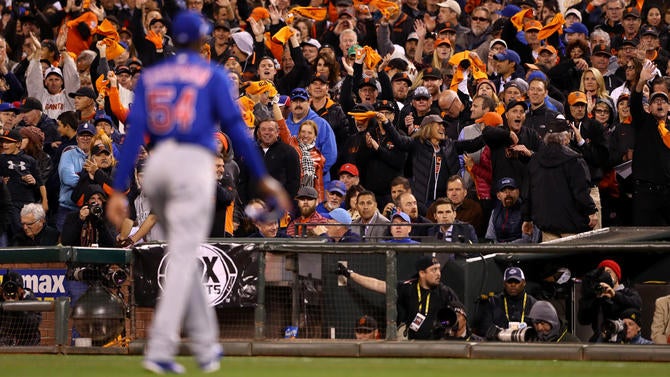
Here's the other thing: If Chapman is still dominant in 2019, he'll be able to trigger his opt-out clause after the season. The Yankees will have gone through all this hard work during their rebuild -- they call it a transition, but it's a rebuild -- only to have their closer bolt when they're ready to win. That's suboptimal.
It is entirely possible that, even if things go according to plan, the Yankees will get only one truly competitive season with Chapman out of this five-year contract. The kids figure to experience some growing pains from 2017-18 -- that's the way it goes -- but if everything falls into place and Chapman is still excellent in three seasons, the opt-out will be looming.
In the very short-term, as in 2017, Chapman will help the Yankees win a few more games and not much else. Remember, the closer only comes into play when the lineup and rotation hold up their end of the bargain. The Yankees had a dominant bullpen this past season (Betances! Miller! Chapman!) and it didn't do them much good because the offense was weak and the rotation was iffy.
A mediocre team -- and let's not mince words, the Yankees have been thoroughly mediocre since 2013 -- spending huge on a closer generally isn't a good idea. Chapman's short-term impact will be marginal, and his long-term value to the Yankees is subject to his opt-out and the inherent risk of relievers. At the same time, if any team is able to swallow an $86 million mistake and paper over it with money, it's the Yankees.













